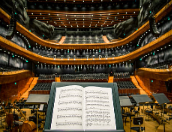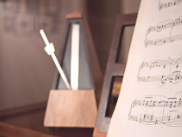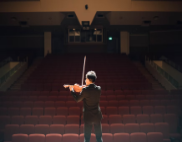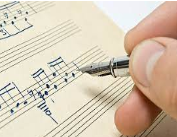The standards for Middle School Instrumental Music, Intermediate Level enable students to continue to develop basic musicianship and music literacy. Students examine inquiry-based questions related to music as part of a creative process. Students increase individual technical skills while developing their understanding of the collaborative skills required to create and refine music for ensemble performance. Music literacy skills are emphasized as students read, notate, sight-read, and perform music. Students respond to, describe, interpret, and evaluate music as performers and listeners, and experience music from a variety of cultural influences, styles, composers, and historical periods. Students compare and contrast career options in music and examine the relationship of instrumental music to the other fine arts. Opportunities are provided for students to participate in local, district, and regional music events as appropriate to level, ability, and interest. The student is usually expected to furnish his or her own instrument. After-school rehearsal and performances may be required of students.
Orchestra 6 or Director Approval
Essential Question: How do I connect with, respond to, perform, and create music?
|
Quarter |
Quarter 1 |
Quarter 2 |
Quarter 3 |
Quarter 4 |
|
Unit Title |
Read, Write, & Perform |
Refine, Practice, Rehearse |
Pathway to Independence |
Reflect, Explore, & Achieve |
|
Image Cue |

|

|

|

|
|
Focus of the Story |
We begin this year exploring how to prepare for an audition and learn more complex technical skills while sight-reading and playing new literature. Students will have the opportunity to learn beginning vibrato. Students will experience how to pace one’s practice to create a successful audition. |
We continue working on scales and developing complex bowing techniques while preparing for All-City Music auditions and the Winter Concert. Students will approach new techniques and exercises to improve their tone. |
We next move to tune independently and to develop critical listening skills. We will learn to adjust to musical nuances, and expand their instrument technique. Students will participate in a District Assessment performance and will be able to refine and improve their playing based on adjudicator feedback. |
We end our year continuing to perform, and preparing solos. We will experiment with music notation technology, and begin exploring a variety of musical career paths. Students will apply previous skills and techniques in their preparation for solo or small ensemble performances. |
|
Transfer Goals |
Use music literacy to demonstrate understanding of the elements of music and the ways they inform artistic performance and creative expression. Analyze, interpret, and evaluate musical works from a variety of cultures. Use technology as a strategic mechanism for improving music literacy and improving music performance. |
Understand and apply creative processes to guide the development of ideas, original works, and musical performance. Analyze, interpret, and evaluate musical works from a variety of cultures. Understand and find meaning in music as a form of community engagement through involvement as a performer, supporter, advocate, and audience member. Use music literacy to demonstrate understanding of the elements of music and the ways they inform artistic performance and creative expression. Explore and connect personal interests, experiences, and aspirations through vocation, advocacy, and arts patronage. |
Understand and apply creative processes to guide the development of ideas, original works, and musical performance. Analyze, interpret, and evaluate musical works from a variety of cultures. Understand and apply creative processes to guide the development of ideas, original works, and musical performance. Use music literacy to demonstrate understanding of the elements of music and the ways they inform artistic performance and creative expression. |
Understand and apply creative processes to guide the development of ideas, original works, and musical performance. Analyze, interpret, and evaluate musical works from a variety of cultures. Understand and find meaning in music as a form of community engagement through involvement as a performer, supporter, advocate, and audience member. Use music literacy to demonstrate understanding of the elements of music and the ways they inform artistic performance and creative expression. Explore and connect personal interests, experiences, and aspirations through vocation, advocacy, and arts patronage. Curate a portfolio of accomplishments, experiences, and performance materials exhibiting oneself as an artist. Use technology as a strategic mechanism for improving music literacy and improving music performance. |
|
Learning Targets |
I can clap, count, and perform rhythms from Sight Reading Factory. I can read, write and perform a 2-octave G Major scale. I can read, write and perform a 2-octave C Major scale. I can understand the STARS method of sight-reading and apply it to new music. I can perform the first 8 measures of the Jr. District Orchestra (JDO) prepared piece with correct intonation and rhythms. I can identify and count in various time signatures. I can prepare for the audition by completing a mock audition. I can reflect on my personal JDO audition. I can demonstrate multiple vibrato skills. I can apply the STARS method of sight-reading to VBODA Grade 1 or 2 sheet music. I can compose and perform an 8-measure melody using a variety of rhythms. I can explain the importance of music in the community and the impact various roles play within it. |
I can demonstrate mastery of bow control and distribution through scales. I can extract important rhythms, articulations, bowings, and other key concepts from my concert literature and apply them in my scales and sight-reading exercises. I can extend method book exercises and apply the concepts to my concert literature. I can apply new rhythms and articulations to the daily scale warm-up. I can explain the importance of historical relevance that various time periods and composers play on music composition. I can demonstrate understanding of whole steps, half steps, and enharmonics and how the function within a scale. I can demonstrate mastery and explain the importance of proper concert etiquette. I can read and interpret the sharps and flats and be able to derive the name of the scale from a given key signature. I can demonstrate growth in mastery throughout the year on my Mid-Year Assessment. |
I can demonstrate mastery of bow control and distribution through scales. I can extract important rhythms, articulations, bowings, and other key concepts from my Assessment literature and apply them in my scales and sight-reading exercises. I can apply concepts from my method book exercises to my assessment literature. I can apply new rhythms and articulations to the daily scale warm-up. I can extract important rhythms, articulations, bowings, and other key concepts from my spring concert literature and apply them in my scales and sight-reading exercises. I can apply exercises and concepts from the method book to my spring concert literature. |
I can demonstrate mastery of bow control and distribution through scales. I can apply concepts from my Assessment literature to extending method book exercises. I can apply new rhythms and articulations to the daily scale warm-up. I can extract important rhythms, articulations, bowings, and other key concepts from my solo or ensemble music and apply them in my scales and sight-reading exercises. I can demonstrate proper concert etiquette. I can explore various music composition software, sound manipulation software, and electronic instruments. I can demonstrate mastery of concepts taught and learned this year through a successful End-of-Year Assessment. |
